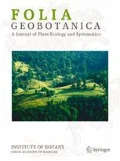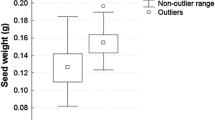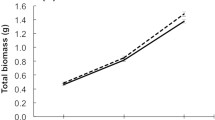Abstract
Generative and vegetative reproduction of diploid and triploidButomus umbellatus L., and growth and biomass production of both cytotypes under two different nutrient levels were compared.
Seedling survival was studied under controlled conditions in a growth chamber; the response of plants to different nutrient conditions was studied in experimental garden.
Both cytotypes do not differ in seed germination and seedling survival. Triploids produce more aboveground and underground biomass, more numerous lateral rhizome buds, and have significantly higher flowering stalks. Low generative reproduction (limited seed production) in triploids is compensated for by more intensive vegetative reproduction. High nutrient level appeared to be stressful for plants of both cytotypes: it limits plant growth and causes plant mortality. Triploids are more viable than diploids in this case, which may be important for their survival under conditions of high trophic level.
Similar content being viewed by others
Literature Cited
Baumann E. (1911): Die Vegetation des Untersee (Bodensee).—Arch. Hydrobiol. Planktonk., suppl. 1: 1–556.
Eriksson O. (1989): Seedling dynamics and life histories in clonal plants.—Oikos 55: 231–238.
Geiger R. (1961): Das Klima der bodennahen Luftschicht.—Braunschweig.
Glück H. (1911): Biologische und morphologische Untersuchungen über Wasser- und Sumpfgewächse. III. Die Uferflora.-Jena.
Hejný S. (1980): Flora a vegetace dvou letněných rybníků ve středních Čechách (Kala u Hostivic, Bucek u Řevníčova) (Flora and vegetation of two summer-drained fishponds in Central Bohemia (Kala near Hostivice, Bucek near Řevníčov)).—Studie ČSAV 1/80, Academia, Praha.
Hroudová Z. (1980): Ekologická studie druhůSagittaria sagittifolia L.,Butomus umbellatus L.,Bolboschoenus maritimus (L.)Palla,Oenanthe aquatica (L.)Poir. (Ecological study ofSagittaria sagittifolia L.,Butomus umbellatus L.,Bolboschoenus maritimus (L.)Palla,Oenanthe aquatica (L.)Poir.).—Ms., PhD thesis, Bot. Inst. CSAS, Průhonice.
Hroudová Z. (1981): Sezónní dynamika porostu obnaženého rybničního dna (Seasonal vegetation dynamics on emerged pond bottom).—Sborn. Jihočes. Muz. Přír. Vědy, 21: 37–49.
Kik C., Linders Th.E. &Bijlsma R. (1992): The distribution of cytotypes in ecologically contrasting populations of the clonal perennialAgrostis stolonifera.—Evol. Trends in Plants, 6 (2): (93–98).
Krahulcová A. &Jarolímová V. (1993): Ecology of two cytotypes ofButomus umbellatus. I. Karyology and breeding behaviour.—Folia Geobot. Phytotax. 28: 385–411.
Levin D. A. (1983): Polyploidy and novelty in flowering plants.—The Amer. Natur. 122 (1): 1–25.
Lohammar G. (1954): Bulbils in the inflorescences ofButomus umbellatus.—Svensk Bot. Tidsskr. 48: 485–488.
Löve A. (1961): Biosystematics and classification of apomicts.—Feddes Repert. 63: 136–148.
Rothera S. &Davy A.J. (1986): Polyploidy and habitat differentiation inDeschampsia caespitosa.— New Phytol., 102: 449–467.
Snedecor G.W. & Cochran W.G. (1971): Statistical methods.-Ames, Iowa.
Sokal R.R. &Rohlf F.J. (1969): Biometry.—Freeman and Co., San Francisco.
Stebbins G.L. (1971): Chromosomal evolution in higher plants.-London.
Šetlík I. (1968): Growth and photosynthetic characteristics of algae.-In:Nečas J. & Lhotský O. [eds.]: Ann. Rep. Algolog. Lab. Třeboň for 1967, pp. 71–140.
Véber K. &Zahradník J. (1986): Dočišt'ování vod autotrofními mikroorganismy a vyššími rostlinami (Waste water final treatment by autotrophic microorganisms and macrophyta).—Studie Čsav 24/86, Academia, Praha.
Velasquez J. (1975): Communities and production ecology ofEleocharis acicularis (L.) R. etSch.-Ms. Diss. (Depon. in Bot. Inst. AS CR Průhonice).
de Wet J.M.J. (1980): Origins of polyploids.—In:Lewis W.H. [ed.]: Polyploidy. Biological relevance.—New York et London, p. 3–15.
Woodhead T.W. & Kirchner O. (1908):Butomaceae.—In:Kirchner O., Loew E. & Schröter C. [eds.]: Lebensgeschichte der Blütenpflanzen Mitteleuropas, Vol. 1/1, Stuttgart, pp. 648–664.
Zákravský P. & Hroudová Z. (1992):Butomus umbellatus L.—pěstování a rozmnožování (Butomus umbellatus L.—cultivation and reproduction).—In: Sborník předn. ze semin. Účelové kultivace vodních a mokřadních rostlin, Třeboň 1992: 31–38.
Author information
Authors and Affiliations
Rights and permissions
About this article
Cite this article
Hroudová, Z., Zákravský, P. Ecology of two cytotypes ofButomus umbellatus II. Reproduction, growth and biomass production. Folia geobot. phytotax. 28, 413–424 (1993). https://doi.org/10.1007/BF02853307
Received:
Accepted:
Issue Date:
DOI: https://doi.org/10.1007/BF02853307




